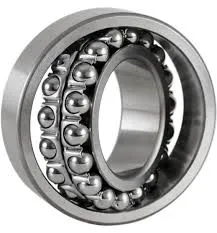
dec . 13, 2024 11:54 Back to list
Understanding the Functionality and Applications of Thrust Roller Bearings in Machinery
Understanding Thrust Rollers An Essential Component in Mechanical Engineering
Thrust rollers are a type of bearing designed specifically to accommodate axial loads in machines and mechanical systems. These cylindrical components are pivotal in various applications, ranging from automotive to industrial machinery, where they provide support and guidance for rotating or moving elements. Understanding thrust rollers involves a comprehensive look at their design, function, and applications, which underscores their importance in engineering.
Design and Structure
Thrust rollers are typically made from high-strength materials such as steel, which offers durability and resistance to wear and tear. Their design often includes a series of rollers positioned between two plates, known as thrust races. The shape of the rollers can vary; they can be cylindrical, tapered, or spherical, depending on the specific load requirements and the nature of the application.
The key aspect of thrust rollers is their ability to handle axial loads - forces that are applied parallel to the shaft of a rotating element. Unlike radial bearings that support loads perpendicular to the shaft, thrust rollers are optimized for scenarios where the primary concern is the axial force. This unique capability makes them suitable for a variety of industrial applications.
Functionality
The primary function of thrust rollers is to reduce friction between moving parts while supporting axial loads. When subjected to forces, these rollers rotate within their races, allowing for smooth motion and minimizing wear on the contacting surfaces. This quality is crucial in applications where constant movement occurs, as it extends the lifespan of machinery and reduces maintenance costs.
Thrust rollers can also absorb vibrations and shocks, which is essential in systems that undergo high-stress conditions. By distributing loads evenly across their surface, they prevent excessive wear on any single point, promoting a longer operational life for the machinery they support.
Applications of Thrust Rollers
Thrust rollers are employed in an array of industries and applications. Here are a few notable examples
thrust roller

1. Automotive Industry In vehicles, thrust rollers are commonly found in automatic transmissions and steering systems, where they help manage the axial loads generated during operation. Their smooth operation is essential for effective vehicle performance and longevity.
2. Industrial Machinery Many types of production machinery use thrust rollers to support components that experience axial forces, such as conveyor systems and robotics. This use helps maintain alignment and improves the efficiency of machinery operations.
3. Aerospace Engineering In the aerospace sector, thrust rollers play a vital role in propulsion systems, assisting in managing loads that arise from engine operations. Their precision and reliability are crucial for safety and performance in aircraft.
Benefits of Thrust Rollers
The integration of thrust rollers in mechanical systems brings several benefits
- Reduction in Friction By providing a rolling element that reduces sliding contact, thrust rollers significantly decrease friction, leading to enhanced efficiency and performance. - Improved Load Capacity With their ability to distribute loads evenly, thrust rollers can manage heavy axial loads without compromising the integrity of the system, which is particularly important in high-stress applications.
- Maintenance and Longevity The design of thrust rollers allows for less frequent maintenance compared to other bearing types. Their durability ensures that they withstand harsh operating conditions, reducing downtime.
Conclusion
In summary, thrust rollers are essential components in the realm of mechanical engineering. Their ability to handle axial loads while minimizing friction makes them indispensable in various applications. As industries continue to evolve, the demand for reliable and efficient machinery will only increase, underscoring the importance of thrust rollers in maintaining optimal performance and safety. Understanding their function and applications can lead to better design choices and improved operational efficiency across numerous sectors. Whether in automobiles, industrial equipment, or aerospace technology, thrust rollers will continue to play a critical role in the advancement of mechanical systems.
Latest news
-
Premium Deep Groove Ball Bearings | High Speed & Reliability
NewsAug.29,2025
-
Durable Scaffolding Clamps - Secure & Reliable Tube Connectors
NewsAug.28,2025
-
Common Failures in Thrust Ball Bearings and Solutions
NewsAug.22,2025
-
How Tapered Roller Bearings Can Take Shock Loads
NewsAug.22,2025
-
Angular Bearings in High-Precision Spindles
NewsAug.22,2025
-
The Impact of Misalignment on Cylindrical Roller Bearing Performance
NewsAug.22,2025
